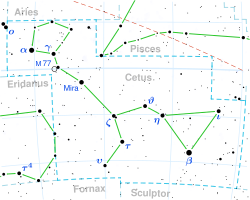| Observation data Epoch J2000 Equinox J2000 | |
|---|---|
| Constellation | Cetus |
| Pronunciation | /ˌtaʊ ˈsiːtaɪ/ |
| Right ascension | 01h 44m 04.083s[1] |
| Declination | −15° 56′ 14.93″[1] |
| Apparent magnitude (V) | 3.50±0.01[2] |
| Characteristics | |
| Evolutionary stage | Main sequence |
| Spectral type | G8V[3] |
| U−B color index | +0.21[4] |
| B−V color index | +0.72[4] |
| Astrometry | |
| Radial velocity (Rv) | −16.68±0.05[5] km/s |
| Proper motion (μ) | RA: −1721.728 mas/yr[1] Dec.: +854.963 mas/yr[1] |
| Parallax (π) | 273.8097 ± 0.1701 mas[1] |
| Distance | 11.912 ± 0.007 ly (3.652 ± 0.002 pc) |
| Absolute magnitude (MV) | 5.69±0.01[2] |
| Absolute bolometric magnitude (Mbol) | 5.52±0.02[2] |
| Details | |
| Mass | 0.69±0.09[6] M☉ |
| Radius | 0.793±0.004[6] R☉ |
| Luminosity | 0.488±0.010[2] L☉ |
| Luminosity (visual, LV) | 0.45[nb 1] L☉ |
| Surface gravity (log g) | 4.48±0.05[6] cgs |
| Temperature | 5,320±40[6] K |
| Metallicity | 28±3% Sun |
| Metallicity [Fe/H] | −0.55±0.05[7] dex |
| Rotation | 46±4 d[6] |
| Rotational velocity (v sin i) | 0.1±0.1[6] km/s |
| Age | 8–10[8] Gyr |
| Other designations | |
| Database references | |
| SIMBAD | data |
| Exoplanet Archive | data |
| ARICNS | data |
Tau Ceti, Latinized from τ Ceti, is a single star in the constellation Cetus that is spectrally similar to the Sun, although it has only about 78% of the Sun's mass. At a distance of just under 12 light-years (3.7 parsecs) from the Solar System, it is a relatively nearby star and the closest solitary G-class star. The star appears stable, with little stellar variation, and is metal-deficient (low in elements other than hydrogen and helium) relative to the Sun.
It can be seen with the unaided eye with an apparent magnitude of 3.5.[2] As seen from Tau Ceti, the Sun would be in the northern hemisphere constellation Boötes with an apparent magnitude of about 2.6.[nb 2][9]
Observations have detected more than ten times as much dust surrounding Tau Ceti as is present in the Solar System. Since December 2012, there has been evidence of at least four planets—all likely super-Earths—orbiting Tau Ceti, and two of these are potentially in the habitable zone.[10][11][12] There is evidence of up to an additional four unconfirmed planets, one of which would be a Jovian planet between 3 and 20 AU from the star.[13] Because of its debris disk, any planet orbiting Tau Ceti would face far more impact events than present day Earth. Note that those planetary candidates have been contested recently[14] and recent discoveries about the stellar inclination cast doubt about the terrestrial nature of these worlds.[6] Despite this hurdle to habitability, its solar analog (Sun-like) characteristics have led to widespread interest in the star. Given its stability, similarity and relative proximity to the Sun, Tau Ceti is consistently listed as a target for the search for extraterrestrial intelligence (SETI).[15]
- ^ a b c d Cite error: The named reference
GaiaDR3was invoked but never defined (see the help page). - ^ a b c d e Cite error: The named reference
aaa494was invoked but never defined (see the help page). - ^ Keenan, Philip C; McNeil, Raymond C (1989). "The Perkins catalog of revised MK types for the cooler stars". Astrophysical Journal Supplement Series. 71: 245. Bibcode:1989ApJS...71..245K. doi:10.1086/191373.
- ^ a b c "Tau Cet". SIMBAD. Centre de données astronomiques de Strasbourg. Retrieved 2018-02-05.
- ^ Nidever, David L.; et al. (2002). "Radial Velocities for 889 Late-Type Stars". The Astrophysical Journal Supplement Series. 141 (2): 503–522. arXiv:astro-ph/0112477. Bibcode:2002ApJS..141..503N. doi:10.1086/340570. S2CID 51814894.
- ^ a b c d e f g Cite error: The named reference
Korolik2023was invoked but never defined (see the help page). - ^ Cite error: The named reference
Tuomi2012was invoked but never defined (see the help page). - ^ Tang, Y. K.; Gai, N. (February 2011). "Asteroseismic modelling of the metal-poor star τ Ceti". Astronomy & Astrophysics. 526: A35. arXiv:1010.3154. Bibcode:2011A&A...526A..35T. doi:10.1051/0004-6361/201014886. S2CID 119099287.
- ^ Cox, Arthur N., ed. (2001-04-20), Allen's Astrophysical Quantities (Fourth ed.), Springer, p. 382, ISBN 0-387-95189-X.
- ^ "Tau Ceti's planets nearest around single, Sun-like star". BBC News. December 19, 2012.
- ^ "Tau Ceti May Have a Habitable Planet". Astrobiology Magazine. December 19, 2012. Archived from the original on 2020-11-06.
{{cite news}}: CS1 maint: unfit URL (link) - ^ Torres, Abel Mendez (December 28, 2012). "Two Nearby Habitable Worlds?". Planetary Habitability Laboratory. University of Puerto Rico. Archived from the original on 2021-03-08. Retrieved 2013-03-22.
- ^ Cite error: The named reference
KervellaArenou2019was invoked but never defined (see the help page). - ^ Cite error: The named reference
Cretignier2021was invoked but never defined (see the help page). - ^ Rutkowski, Chris A. (2010), The Big Book of UFOs, Dundurn, p. 33, ISBN 978-1554887606
Cite error: There are <ref group=nb> tags on this page, but the references will not show without a {{reflist|group=nb}} template (see the help page).
